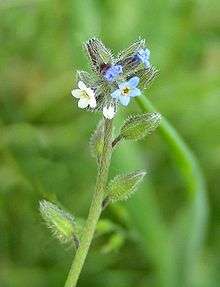Boraginaceae
| Boraginaceae | |
|---|---|
 | |
| Changing forget-me-not (Myosotis discolor) | |
| Scientific classification | |
| Kingdom: | Plantae |
| Clade: | Angiosperms |
| Clade: | Eudicots |
| Clade: | Asterids |
| Order: | Boraginales |
| Family: | Boraginaceae Juss.[1] |
| Subfamilies | |
Boraginaceae, the borage or forget-me-not family, includes a variety of shrubs, trees, and herbs, totaling about 2,000 species in 146 genera found worldwide. [3]
According to the APG II, the Boraginaceae belongs among the euasterid I group, including the orders Gentianales, Lamiales, and Solanales, but whether it should be assigned to one of these orders or to its own (Boraginales) is still uncertain. Under the older Cronquist system it was included in Lamiales, but it is now clear that it is no more similar to the other families in this order than they are to families in several other asterid orders. The Boraginaceae is paraphyletic with respect to Hydrophyllaceae and the latter is included in the former in the APG II system. In some recent classifications the Boraginaceae is broken up into several families: Boraginaceae sensu stricto, Cordiaceae, Ehretiaceae, Heliotropiaceae, Lennoaceae, and Hydrophyllaceae.
These plants have alternately arranged leaves, or a combination of alternate and opposite leaves. The leaf blades usually have a narrow shape; many are linear or lance-shaped. They are smooth-edged or toothed, and some have petioles. Most species have bisexual flowers, but some taxa are dioecious. Most pollination is by hymenopterans, such as bees. Most species have inflorescences that have a coiling shape, at least when new. The flower has a usually five-lobed calyx. The corolla varies in shape from rotate to bell-shaped to tubular, but it generally has five lobes. It can be green, white, yellow, orange, pink, purple, or blue. There are five stamens and one style with one or two stigmas. The fruit is a drupe, sometimes fleshy.[4]
Most members of this family have hairy leaves. The coarse character of the hairs is due to cystoliths of silicon dioxide and calcium carbonate. These hairs can induce an adverse skin reaction, including itching and rash in some individuals, particularly among people who handle the plants regularly, such as gardeners. In some species, anthocyanins cause the flowers to change color from red to blue with age. This is may be a signal to pollinators that a flower is old and depleted of pollen and nectar.[5]
Well-known members of the family include:
- alkanet (Alkanna tinctoria)
- borage (Borago officinalis)
- comfrey (Symphytum spp.)
- fiddleneck (Amsinckia spp.)
- forget-me-not (Myosotis spp.)
- geigertree (Cordia sebestena)
- green alkanet (Pentaglottis sempervirens)
- heliotrope (Heliotropium spp.)
- hound's tongue (Cynoglossum spp.)
- lungwort (Pulmonaria spp.)
- oysterplant (Mertensia maritima)
- purple viper's bugloss/Salvation Jane (Echium plantagineum)
- Siberian bugloss (Brunnera macrophylla)
- viper's bugloss (Echium vulgare)
Genera
- Actinocarya
- Adelocaryum
- Afrotysonia
- Alkanna
- Amblynotus
- Amphibologyne
- Amsinckia
- Anchusa
- Ancistrocarya
- Anoplocaryum
- Antiotrema
- Antiphytum
- Arnebia
- Asperugo
- Auxemma
- Borago
- Bothriospermum
- Bourreria
- Brachybotrys
- Brunnera
- Buglossoides
- Caccinia
- Carmona
- Cerinthe
- Chionocharis
- Choriantha
- Cordia
- Craniospermum
- Cryptantha
- Cynoglossopsis
- Cynoglossum
- Cynoglottis
- Cysostemon
- Dasynotus
- Decalepidanthus
- Echiochilon
- Echiostachys
- Echium
- Ehretia
- Elizaldia
- Embadium
- Emmenanthe
- Eritrichium
- Gastrocotyle
- Gyrocaryum
- Hackelia
- Halacsya
- Halgania
- Harpagonella
- Heliocarya
- Heliotropium
- Heterocaryum
- Huynhia
- Ivanjohnstonia
- Ixorhea
- Lacaitaea
- Lappula
- Lasiarrhenum
- Lasiocaryum
- Lepechiniella
- Lepidocordia
- Lindelophia
- Lithodora
- Lithospermum
- Lobostemon
- Macromeria
- Maharanga
- Mairetis
- Mattiastrum
- Mertensia
- Metaeritrichium
- Microcaryum
- Microula
- Mimophytum
- Moltkia
- Moltkiopsis
- Moritzia
- Myosotidium
- Myosotis
- Neatostema
- Nesocaryum
- Nogalia
- Nomosa
- Nonea
- Ogastemma
- Omphalodes
- Omphalolappula
- Omphalotrigonotis
- Onosma
- Oxyosmyles
- Paracaryum
- Pardoglossum
- Patagonula
- Pectocarya
- Pentaglottis
- Perittostema
- Phacelia
- Plagiobothrys
- Pseudomertensia
- Psilolaemus
- Pulmonaria
- Rindera
- Rochefortia
- Rochelia
- Rotula
- Saccellium
- Scapicephalus
- Sericostoma
- Sinojohnstonia
- Solenanthus
- Stenosolenium
- Stephanocaryum
- Suchtelenia
- Symphytum
- Thaumatocaryum
- Thyrocarpus
- Tianschaniella
- Tiquilia
- Tournefortia
- Trachelanthus
- Trachystemon
- Trichodesma
- Trigonocaryum
- Trigonotis
- Ulugbekia
- Valentiniella
References
- ↑ Angiosperm Phylogeny Group (2009). "An update of the Angiosperm Phylogeny Group classification for the orders and families of flowering plants: APG III" (PDF). Botanical Journal of the Linnean Society. 161 (2): 105–121. doi:10.1111/j.1095-8339.2009.00996.x. Retrieved 2013-07-06.
- ↑ "Boraginaceae Juss., nom. cons.". Germplasm Resources Information Network. United States Department of Agriculture. 2007-04-12. Retrieved 2009-04-02.
- ↑ Boraginaceae. Diversityoflife.com
- ↑ Watson, L. and M. J. Dallwitz. 1992 onwards. Boraginaceae Juss. Archived July 1, 2005, at the Wayback Machine. The Families of Flowering Plants. Version: 19 August 2013.
- ↑ Hess, D. 2005. Systematische Botanik. ISBN 3-8252-2673-5
External links
| Wikimedia Commons has media related to Boraginaceae. |
| Wikisource has the text of the 1911 Encyclopædia Britannica article Boraginaceae. |
- Distribution Map And Genus list At Boraginaceae At Boraginales At: Trees At: APweb At: Missouri Botanical Garden
- Boraginaceae In:Mabberley's Plant-Book
- Boraginaceae At: Plant Names At: IPNI
- Home page of James L. Reveal and C. Rose Broome
- Boraginaceae (Search Exact) At Name Search At: Tropicos At: Missouri Botanical Garden
- Boraginaceae. Topwalks.net: Walking Routes in Spain.
- Boraginaceae. Integrated Taxonomic Information System (ITIS).
Further reading
- Diane, N., et al. 2002. A systematic analysis of Heliotropium, Tournefortia, and allied taxa of the Heliotropiaceae (Boraginales) based on ITS1 sequences and morphological data. American Journal of Botany 89(2), 287-95.
- Gottschling, M., et al. (2001). Secondary structure of the ITS1 transcript and its application in a reconstruction of the phylogeny of Boraginales. Plant Biology 3, 629-36.